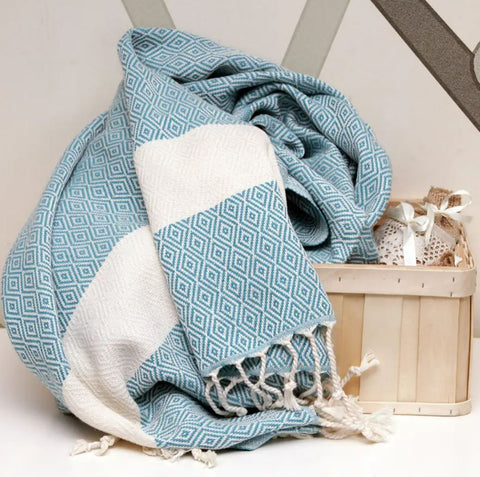
Turkish towels, aka peshtemals/pestemals, have quite a long history! These hand loomed towels have been used for centuries, from the hammams ('Turkish baths' in modern times) of the Ottoman Empire, to modern day spas and home use around the world. But what makes them so special, and how do you care for them?

The Turkish towels that Nomad Girl carries are hand loomed in Turkey by expert traditional artisans, using an antique, traditional 16th-century loom called Kara Tezgah. Our towels were handmade in the city of Buldan, where Turkish towels orginiate from! This are is also known for the quality cotton that is grown and then used by the expert weavers there.
Why have Turkish towels been sought after for centuries? It's all about the cotton! Turkish cotton has a longer fiber resulting in smoother and stronger strands. This makes very durable when turned into thread, and is less likely to pill or break. Turkish towels will also get softer and more absorbent as you wash them, so don't be afraid to use them regularly!
Turkish towels will not become fluffy like the towels you may be used to; but the multiple positives outweigh the 'fluff'!
-
More absorbent:
Fluffy does not equal absorbent! The secret is in the cotton fibers content. These towels are incredibly wicking and efficient. When used in a patting motion, they will dry you off in no time! -
Dries quickly:
While the towels are very absorbent, they also dry very quickly! This may seem counterintuitive since they hold so much water, but their light weight is advantageous for drying. This also means that they tend to have less bacteria growth, since the towel does not remain damp for as long as a standard towel. -
Lightweight:
Takes up less room, great for travel and small storage areas. -
Eco-friendly:
If properly cared for, Turkish towels are very durable and should last for many years, or even decades! The likelihood of Turkish towels reaching a landfill is significantly less than a standard towel, which tends to run through a course of use within just a handful of years of regular usage. You also do not use fabric softener or tumble drying, which alone makes them a more eco-friendly choice!
Read on to learn how to care for and use your Turkish Towel!

Turkish towels are one of the most versatile linens for your home, as they can be used in a variety of ways! Some of the most common uses are:
- Bath towel
- Beach towel (they work well for repelling sand!)
- Tablecloth
- Bedspread
- Throw blanket
- Scarf or sarong
- Hair towel (Throw your wet hair up in one of our towels and you'll be surprised! Your neck will thank you)
Turkish Towels are also easy to take care of!
An important note is that before you use it for the first time, wash the towel in either cold or lukewarm water on a gentle cycle-either on its own, or with similar colors. This will 'lock' the fibers/threads, and will help the towel to be absorbent from the first use. DO NOT use fabric softener or bleach on Turkish towels, since this will make your towel less absorbent.
To dry your Turkish towel, we recommend hang drying them. This will help preserve and prolong the life of your towel. Since it dries so quickly, it will not have to hang dry for overly long. If you absolutely must dry it, do so on low to medium heat. You can also use a warm iron to smooth out unwanted wrinkles and creases.
Troubleshooting pulled threads and untwisted fringe:
In the event that your towel gets caught on something and a thread gets pulled a bit out, don't fret! You can simply cut off the piece of thread that is popping out. As your towel is woven, cutting this single piece won't cause it to unravel. After a wash, you may also find that a piece of fringe has come undone. Again, this is an easy fix! Simply separate the threads into two equal sections. Twist each section in a clockwise motion. Then twist the two sections together in a counter-clockwise motion. Tie the knot off at the end and you're good to go!
Click here to explore our Turkish Towels: Turkish Towels



